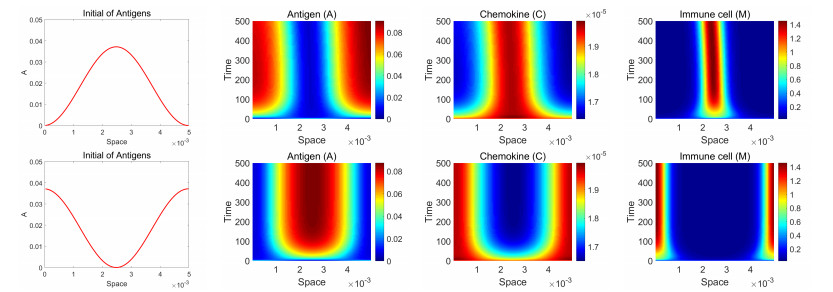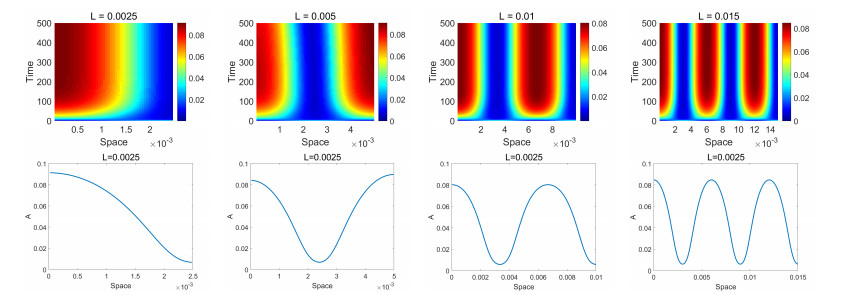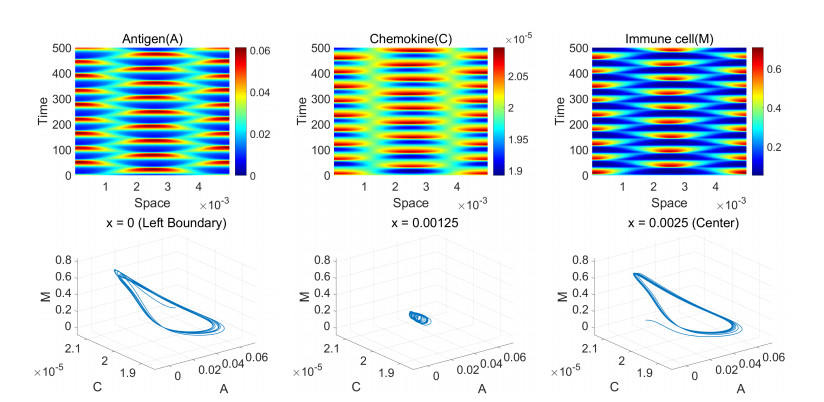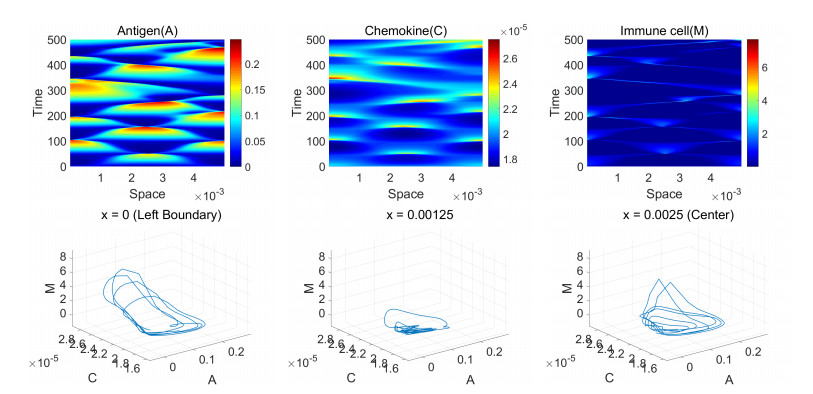1.
Introduction
Chemotaxis is a directed movement of biological individuals in response to a chemical signal. It is well-known that the chemotaxis can significantly affect the immune system (see [1,2]). To be more specific, during the immune process, a chemical which is called chemokine is secreted by the immune cell at sites of inflammation. Then, eukaryotic cells sense the gradient of chemokines by a polarized distribution of receptors, and they move toward relatively high concentrations of the chemical (chemoattraction), or in the opposite direction (chemorepulsion). Thus, chemotaxis seems to be a key contribution to the spatial properties of the solutions to immune systems, such as pattern formations or stabilization.
The immune system is regulated by various immune cells and dysregulation of the immune system is associated with some kinds of diseases. Immunodeficiency occurs when the immune response is less active, whereas hypersensitivity to the immune response is associated with many allergic diseases (see [3,4]). There have been several results to analyze the dynamics by using a mathematical model (see [5,6,7,8,9]). However, due to many variables and their complex coupling, it is not easy to understand the mechanism mathematically.
In this regard, Lee et al. [10] proposed a simplified PDE system involving only three main factors; antigens, chemokines and immune cells. The modelling is motivated by the pioneer work of Keller and Segel [11], which studies the aggregation of cellular slime mold toward a higher concentration of a chemical signal. Lee et al. obtained the stability and instability conditions for the uniform steady states and provided numerical observations. In this paper, we investigate the following reaction-diffusion-advection system introduced in [10]
where Ω is a smoothly bounded domain in Rn, n=1,2. The unknowns A, C, and M represent the concentration of antigens, the concentration of chemokines, and the density of immune cells, respectively. Each equation of (1.1) contains a uniform diffusion with a constant coefficient and natural degradation with a constant decay rate. The constant antigen source sA>0 represents the persistent infection. Since immune cells are produced in bone marrow and circulated throughout the body, we also consider the source of M as a positive constant sM>0. During the immune process, immune cells and antigens are consumed by regulation and phagocytosis, which are denoted by λMMA and λAMA, respectively. On the other hand, sCMA indicates that chemokines are secreted by immune cells depending on the mass of antigens. The chemosensitivity χ>0 in the advection term contributes to the movement of immune cells toward the gradient of chemokines. For the reader's convenience, we provide Figure 1 introduced in [10], which shows interactions between A, C and M.
We supplement this system with the conditions of nonnegative initial values such that for p>n,
and with the homogeneous Neumann boundary conditions
where ν denotes the outward normal vector to the boundary ∂Ω.
The aim of this work is to verify the global solvability of (1.1)–(1.3) and show the occurrence of pattern formations. The rest of this paper is organized as follows. Section 2 is devoted to show the global existence and uniqueness of classical solutions. In the one-dimensional setting, the existence can be shown without any restriction on χ or initial conditions. However, in the case of two dimensions, due to the similarity to the minimal Keller-Segel model, the existence can be obtained under a restriction that depends on the initial conditions and coefficients. One of the main theorems (Theorem 2.1) will be followed by some Lemmas and a priori estimates. In Section 3, we present the stability of nonconstant steady states and existence of periodic orbits. Numerical results are given in Section 4. We close the paper in Section 5 with discussions and conclusions.
Throughout this paper, c denotes a positive generic constant which may differ from line to line.
2.
Global existence
In this section, we prove the existence of classical solutions to (1.1). Looking at the first equation of (1.1), we can see that the nonlinear phagocytosis effect −λAMA, due to its negative sign, does not play any role in the blow-up of A and thus A is uniformly bounded in time unless sA is singular. From the second equation of (1.1), the production of chemokines can not exceed a linear proportional to M, and we thereby find a similar structure to the Keller-Segel model. Similarly to −λAMA, the nonlinear regulation −λMMA in the third equation of (1.1) can not be a crucial obstacle to guarantee the boundedness of M. In general, the qualitative properties of the solutions to the minimal Keller-Segel model like boundedness or blow-up phenomena highly depend on the spatial dimension (see [12,13,14,15,16,17]). For this reason, we shall provide the proofs for each dimension.
2.1. Preliminaries
First, we introduce some useful estimates related to the heat semigroup (see [18,17]).
Lemma 2.1. Let {eΔt}t≥0 be the heat semigroup in a bounded domain with the homogeneous Neumann boundary condition and let λ1>0 be the first positive eigenvalue of the Laplace operator −Δ. Then, for any 1≤q≤p≤∞, there exists c=c(p,q,Ω)>0 such that
for all w∈Lq(Ω);
for all w∈Lq(Ω).
Next, we assert the local existence of solutions to (1.1) and boundedness of L1-norm. Due to the presence of reaction terms, the total mass is not conservative. But we can still obtain the uniform boundedness of the total mass in time.
Lemma 2.2. Let Ω be a smooth bounded domain of Rn, n≥1. For any (A0,C0,M0) satisfying (1.2), we have:
(1) There exists a maximal time of existence Tmax>0 such that the system (1.1) with (1.3) has a unique nonnegative classical solution satisfying
(2) If Tmax<∞, then we have
(3) There exists a positive constant C1 such that
In particular, we have
(4) There exists a positive constant C2 such that
Proof. We let U=(M,C,A) and rewrite (1.1) with (1.2), (1.3) as
where
The real parts of eigenvalues of A(U) are all positive and hence (2.8) is uniformly parabolic. Then, by Amman's well-established parabolic theory introduced in [19, Theorem 7.3] (see also see [20,21] for similar approaches), we obtain the local existence, uniqueness of solutions fulfilling (2.3) and blow-up criterion (2.4). The maximum principle ensures the nonnegativity of the solution. More precisely, we observe that the first and third component of F(U) are nonnegative, due to sM,sA>0, when M=0, A=0. Then, the nonnegative initial values (A0,M0) imply that (A,M) is also nonnegative. From the nonnegativity of (A,M) and the initial value C0, we obtain the nonnegativity of C. To show (2.5), we multiply the first equation, the third equation of (1.1) by sC and the second equation by λA+λM, respectively, and add them up. Then, integrating the result over Ω gives
Letting sC∫ΩA(⋅,t)+(λA+λM)∫ΩC(⋅,t)+sC∫ΩM(⋅,t):=y(t), we infer from (2.9) that there exist positive constants c1, c2 such that
which guarantees the uniform boundedness (2.5). As to (2.6), we integrate the third equation of (1.1) over Ω to obtain
Solving the ordinary differential inequality (2.10) with M0, we obtain (2.6). For the last, we consider the following parabolic auxiliary problem for the equation of A
Now, we apply (2.1) to the Duhamel formulation of (2.11) as
Then, we have
By the standard comparison principle for parabolic equation (see [22]), we obtain
This completes the proof.
2.2. One dimensional case
In this subsection, we consider an one-dimensional problem. In this case, gradient estimate of C is essential to show the global existence.
Lemma 2.3. Let n=1 and (A,C,M) be a classical solution of (1.1) in Ω×(0,Tmax). Then, we have
where the positive constant c is independent of Tmax.
Proof. We apply the estimates of Lemma 2.1 to the Duhamel formulation of second equation of (1.1) as the following equation
Using (2.1), (2.6) and (2.7), we deduce from (2.14) that for any t∈(0,Tmax)
where c is independent of t and λ1 is the first positive Neumann eigenvalue of the Laplace operator −Δ on Ω. Since the two integral terms in (2.15) are uniformly bounded in t, this completes the proof.
The boundedness of ‖M‖Lp follows from (2.13).
Lemma 2.4. Let n=1, p>1 and (A,C,M) be a classical solution of (1.1) in Ω×(0,Tmax). Then, we have
where the positive constant c depends on p.
Proof. Testing the last equation of (1.1) by Mp−1 for any p>1, we have
Using (2.13), the Gagliardo-Nirenberg inequality, and Hölder's inequality, we compute
where c3 and c4 are positive constants independent of p. Combining (2.17) and (2.18), we see that
where c5=c4+1. Note from the Gagliardo-Nirenberg inequality and (2.6) that
holds for some positive constants c6,c7,c8 and θ1=p/2−1/2p/2+1/2∈(0,1). Plugging (2.20) into (2.19), we obtain
where c9=(p−1)spM|Ω|+2DM(p−1)p. Since 1θ1>1, by a standard ODE comparison, we conclude that
where the positive constant c depends on p.
By the application of bootstrap arguments, we prove the uniform boundedness of A, C and M as desired.
Lemma 2.5. Let n=1 and (A,C,M) be a classical solution of (1.1) in Ω×(0,Tmax). Then, we have
where the positive constant c is independent of Tmax.
Proof. Let 0<T<Tmax. The boudnedness of A for t∈(0,T) is a direct consequence of (2.7). As to the estimate of C, applying the estimates of Lemma 2.1 to (2.14) with (2.7) and (2.16), we have for any p>1
where c is independent of T. Now, we apply the Moser-Alikakos iterative technique [23] to show the boundedness of M. Adding p3(p−1)∫ΩMpdx to the both sides of (2.19), we have
where c10=c5+1. Interpolation inequality entails
where c11 is a positive constant independent of p. Therefore, (2.21) turns into
We integrate (2.22) in time to obtain
where c12 is a positive constant independent of p. We define
Thus, we rewrite (2.23) as
where c13 is a positive constant independent of p. Taking p=2i, i=1,2,⋯, we have
where c14=c1324∑∞j=1j2j. Letting i→∞, we have
where c14 is independent of t. Since T<Tmax is arbitrary, we complete the proof.
2.3. Two dimensional case
In this subsection, we deal with the case of two spatial dimensions. First, we derive the uniform boundedness of ‖MlogM‖L1(Ω) and ‖∇C‖L2(Ω)under a smallness condition on M1. When the total mass of M is conserved, a Lyapunov functional is a helpful tool to prove the global existence (see [15]). However, due to reaction terms, the construction of a Lyapunov functional for this problem is very challenging. Instead, we use the Poincare inequality and the Cauchy-Schwarz inequality.
Lemma 2.6. Let n=2 and (A,C,M) be a classical solution of (1.1) in Ω×(0,Tmax). Then, for a sufficiently small M1, we have
where the positive constant c is independent of Tmax.
Proof. Testing the third equation of (1.1) by logM, the integration by parts implies
where we used Young's inequality. Using (2.7), we find that there exists a positive constant c15>0 such that
Thus, (2.25) turns into
where we used the inequality x−logx>0 for x>0. On the other hand, we test the second equation of (1.1) by −ΔC to obtain
Combining (2.26) and (2.27), we have
Adding (2μC−μM)∫ΩMlogM to the both sides of (2.28), we obtain
If μM≤2μC, then (2.29) turns into
For the other case μM>2μC, due to the positive uniform bound of −xlogx for x>0, we find a positive constant c16 such that
Now letting Mave(t):=1|Ω|∫ΩM(⋅,t), the Poincare inequality gives
where cΩ is a positive constant satisfying
By the Cauchy-Schwarz inequality, we deduce from (2.32) that
Plugging (2.33) into (2.30) or (2.31), it follows from (2.6) that
for some c17,c18>0. Note that c17 depends on χ and it is independent of M1, whereas c18 depends on M1. Therefore, if M1 is sufficiently small so that M21≤DMC17, then (2.31) ends up with
Solving this inequality directly, we completes the proof.
Thanks to the work done by Bellomo et al. [24], the boundedness of ∫ΩMlogM and ∫Ω|∇C|2 are sufficient to obtain the global existence.
Lemma 2.7. Let n=2 and (A,C,M) be a classical solution of (1.1) in Ω×(0,Tmax). Then, for the same assumption on M1 as in Lemma 2.6, we have
where the positive constant c is independent of Tmax.
Proof. Detailed proofs can be found in [24,Lemma 3.3].
Now, we are in position to prove our first main theorem which gives the existence of a global-in-time classical solution to (1.1) for n=1,2.
Theorem 2.1. Let Ω be a smooth bounded domain of Rn. If n=1 or M1 is sufficiently small for n=2, then, the system (1.1)–(1.3) possesses a unique global-in-time nonnegative uniformly bounded classical solution (A,C,M) in Ω×(0,∞) such that
Proof. Suppose that Tmax<∞. According to Lemma 2.5 and Lemma 2.7, there exists c>0 such that
where c is independent of Tmax. This is contrary to Theorem 2.2 which implies Tmax=∞. We complete the proof.
3.
Stability and bifurcation
In this section, we analyze the bifurcation of the system (1.1). For simplicity, we consider the one-dimensional case :
where the domain length L is a positive constant. Recalling the work in [10], we find that the system (1.1) has the unique positive equilibrium (¯A,¯C,¯M) such that
where
We the following functions spaces:
From the equilibrium (3.2), we can rewrite the system (3.1) in the following abstract form:
where z(x,t)=(a,c,m):=(A−¯A,C−¯C,M−¯M), and Lχ:H1→H, Gχ:H1→H satisfy
To obtain the principle of exchanging stability, we focus on the linearized system of (3.3)
Now, we express z=(a,c,m) as
and then the linearized system (3.4) is equivalent to the following eigenvalue problem:
where Mk is a 3×3 matrix such that
The principle of exchanging stability is determined by the sign of eigenvalues of each Mk, and we have the following proposition (see [10, Lemma 1]).
Proposition 3.1. The equilibrium (¯A,¯C,¯M) of (3.1) is locally asymptotically stable if χ<χc=mink≥1{χSk,χHk} and it is unstable if χ>χc, where
with
Proof. Let Λ1k, Λ2k, and Λ3k be eigenvalues of Mk. By the Routh-Hurwitz criterion, ReΛik<0 for all k=1,2,3,⋯ and j=1,2,3 if and only if
where
Then, one can easily check that (3.9) completes the proof. The details can be found in [10,Lemma 1].
3.1. Pitchfork bifurcation
In this section, we examine the nonconstant steady state solution to (3.1) when χc=mink≥1χSk<mink≥1χHk. Then, there exists k0≥1 such that χSk0=χc. Let Λ1k(χ), Λ2k(χ) and Λ3k(χ) be the eigenvalues of Mk with ReΛ1k(χ)≥ReΛ2k(χ)≥ReΛ3k(χ). Then, Λ1k0(χ) is the first real eigenvalue of (3.1) which changes its stability at χ=χc, i.e., we have
By Proposition 3.1, the system (3.1) bifurcates from the equilibrium (¯A,¯C,¯M) to another steady state solution as χ increases passing through χc. Before we state the theorem of steady state bifurcation below, we introduce the following parameter K3:
where
and ψ(x)=(ψ1(x),ψ2(x),ψ3(x))∈H1 satisfies
with
Theorem 3.1. Let χSk0=mink∈NχSk<mink∈NχHk for some k0∈N, and let K3 be given as in (3.11). Suppose that χ>0 satisfies χ>χSk0. If K3>0, then there exist two bifurcated solutions zχ±=(aχ,cχ,mχ)T to (3.1), which are attractors. Moreover, zχ± can be expressed as
where ξ1k0 is given as in (3.13). And if K3≤0, then there are no bifurcated solutions.
Proof. We use a similar method introduced in [25,Theorem 4.2] based on the center manifold theory (see e.g., [26]). Let Φ be the center manifold function of the equation (3.3) at χ=χc. Since Mk0|χ=χc has a simple zero eigenvalue with the eigenvector ξ1k0 in (3.14), we can express z as
and the equation (3.3) is decomposed as the following:
where P1:H→span{z1k0}⊂H and P2:H→span{z1k0}⊥ are the natural projections. Then the bifurcation type of the equation (3.3) completely depends on the first equation of (3.15). Let z1∗k0=ξ1∗k0cosk0πxL, where ξ1∗k0 is the eigenvector of M∗k0|χ=χc corresponding to the zero eigenvalue. Taking the H-inner product to the both sides of the first equation of (3.15) by z1∗k0, we can get the following equation:
where (⋅,⋅) denotes the H-inner product. Since we consider χ near χSk0, Gχ can be approximated by GχSk0. Due to the form of GχSk0 and Φ(yz1k0)=O(y2) (see [26]), we can express g as
Direct calculations yield that
which has the factor ∫L0cos3k0πxLdx=0. To calculate K3, we let
with u=(u1,u2,u3)T and v=(v1,v2,v3)T. Then, we can write GχSk0(z)=G2(z,z). Since Φ(yz1k0)=O(y2), we have
and, with the aid of Theorem A.1.1 in [26], Φ satisfies LχΦ=−P2GχSk0(yz1k0). Note that GχSk0(yz1k0)∈span{z1k0}⊥={w∈H|(w,z1∗k0)=0} because ∫L0cos3k0πxLdx=0. Therefore, ψ satisfies (3.12) and we have
which is calculated as in (3.11). Hence, the system (3.1) has a pitchfork type bifurcation and we complete the proof as desired.
3.2. Hopf bifurcation
In this subsection, we consider the case χc=mink≥1χHk<mink≥1χSk, which may give rise to the existence of periodic solutions. Let k1 be the positive integer satisfying χk1=χc. Then, there exists at least one eigenmode k such that χHk<χSk. Recalling from Lemma 1 in [10], we calculate the characteristic polynomial of Mk as Λ3+PkΛ2+(Qk,0−χQk,1)Λ+(Rk,0−χRk,1) with Pk, Qk,0, Qk,1, Rk,0 and Rk,1 given in (3.8). By the Routh-Hurwitz criterion, for a such mode k with χHk<χSk and the choice of χ=χHk, Mk has two pure imaginary and one negative eigenvalues:
To obtain the existence of the Hopf bifurcation, we apply the bifurcation theory from [27] and we check the transversality condition. The similar proof can be found in [28,Theorem 3.1].
Theorem 3.2. Let mink∈NχHk<mink∈NχSk. For each k∈N, we suppose that 0<χHk<χSk and χHj≠χHk for any j≠k, j∈N. Then, there exist δ>0 and a unique one-parameter family of nontrivial periodic orbits ρk(s)=(zk(s,x,t),Tk(s),χk(s)):s∈(−δ,δ)→C3(R,H1)×R+×R satisfying (zk(0,x,t),Tk(0),χk(0))=(0,2πζk,χHk) and
such that (zk(s),χk(s)) is a nontrivial solution of (3.3) and zk(s) is periodic with period Tk(s)≈2πζk where ζk=√Qk,0−χHkQk,1 and ξ1,2k are the eigenvectors of Mk|χ=χHk corresponding to Λ1,2k(χHk). Moreover, ρk(s1)≠ρk(s2) for all s1≠s2, s1,s2∈(−δ,δ) and all nontrivial periodic solutions of (3.3) around (0,χHk) must be on the orbit ρk(s) in the sense that, if (3.3) has a periodic solution ˜z(x,t) with period T for some χ∈R around ρk(s) such that for small ϵ>0 |χ−χHk|<ϵ, |T−2π/ζk|<ϵ and maxt>0,x∈[0,L]|˜z(x,t)|<ϵ, then there exist numbers s∈(−δ,δ) and some θ>0 such that (T,χ)=(Tk(s),χk(s)) and ˜z(x,t)=zk(s,x,t+θ).
Proof. The proof is based on Theorem 1.11 in [27]. Consider the case of an eigenmode k∈N with χHk<χSk. Since the diffusion coefficients DA, DC and DM are all positive, the system (3.3) is normally parabolic. Also since χHk≠χHj for all k≠j, k,j∈N, the matrix Mk|χ=χHk has no eigenvalues of the form iNζk for N∈Z−{−1,1}, and by the Routh-Hurwitz criterion, 0 is not an eigenvalue of Mk|χ=χHk.
Let Λ1,2k(χ)=η(χ)±iζ(χ) and Λ3k(χ) be the eigenvalues of Mk with χ around χHk. To complete the proof, we check the following transversality condition
By the relation between the roots and coefficients of the caracteristic equation of Mk, we obtain that
Differentiating the above equations with respect to χ, we obtain that
and
Since η(χHk)=0 and Λ3k(χHk)=−Pk, we solve (3.21) with χ=χHk to obtain
so that η′(χHk)=−12Λ3k′(χHk)>0. This completes the proof.
4.
Numerical simulations
In this section, we provide numerical examples of stable and time-periodic solution to the system (3.1) for the one dimensional case. We use the upwind finite volume scheme introduced in [29,30]. The parameter sets are given in Table 1 introduced in [10]. Since the model is simplified, it is not easy to find all the parameters estimated from the experiments. The diffusion coefficients and decay/death rates are usually known (see [31,9] and references therein). For example, the diffusion coefficient DM is estimated in a range of 10−11–10−7cm2/h (see [32]). In this work, we choose DM=5×10−7cm2/h in the range. We choose domain length L=(half of some integers)×0.005m, which is relevant to contain a sufficient number of cells considering the size of the cells.
4.1. Nonconstant stable steady states
By direct computations with (3.2) and Proposition 1, we obtain a positive constant equilibrium (¯A,¯C,¯M)≈(1.86×10−2,1.93×10−5,2.59×10−1) and Qk,0Rk,1>Qk,1Rk,0 for all k∈N, which implies that χSk<χHk for all k∈N.
First we observe the chemotactic effect in a fixed domain length L=0.005 with varying χ. In this case, we have mink∈NχSk=χS2≈1.097. Thus, if we choose χ>1.097, then the system bifurcates from the equilibrium to another stable steady state solution. In Figure 2, we illustrate steady state solutions of A, C and M with χ taken to be 1.15, 1.6 and 2. We see that A has an interior spike, and C and M have boundary layers on each boundary. As χ increases, the solutions become more aggregated.
In Figure 3, there are two steady state solutions with different structures. Theorem 3.1 indicates that the system (3.1) has two bifurcated stable steady solutions in case of χc=mink∈NχSk<mink∈NχSk. Figure 3 shows that the structure of bifurcated solutions depends on the initial condition. Figure 4 illustrates the simulation in several cases of domain lengths, L=0.0025,0.005,0.01,0.015, and for each case, χ=1.2,1.15,1.07,1.065 are chosen. We see from Table 2 that the stable steady solutions have the profile cosk0πxL when χ is slightly bigger than χSk0=mink∈NχSk. These numerical results in Figure 3 and 4 agree with the theoretical results of Theorem 3.1.
4.2. Time-periodic solutions
From Table 1, we find the positive constant equilibrium (¯A,¯C,¯M)=(2.00×10−2,2.00×10−5,2.50×10−1) and mink∈NχHk≈1.04<mink∈NχSk≈14. In this case, by Theorem (3.2), the system (3.1) posseses time-periodic solutions.
Figure 5 illustrates time-periodic solutions to (3.1) with parameters of Table 1 and L=0.005 when χ=1.085 is chosen slightly bigger than mink∈NχHk=χH2≈1.08. Letting ζk(χ)=√Qk,0−χQk,1, we compute the period of the solution as T=2πζk(χH2)≈49.2. Figure 6 shows the spatial profile of time periodic solutions featuring cosk1πxL, where k1=argmink∈NχHk for varying domain size L=0.0025,0.005,0.01,0.0125. Then, k1 and χHk1=mink∈NχHk are given in Table 3.
5.
Conclusions and discussions
In this paper, we investigate the global solvability and bifurcation dynamics of the system (1.1) with the boundary condition (1.3) introduced in [10]. The system (1.1) has a minimal type of chemotactic sensitivity, i.e., constant χ=const. Due to a similar structure to the classical Keller-Segel model (see [11]), the global solvability of the problem depends on the dimension. In the one dimensional case, the global existence and uniform boundedness of solutions can be proved for any χ>0. However, in the two dimensional case, the global solvability of this model is obtained under smallness assumptions (see [15] for Keller-Segel model case).
In view of the stability analysis, it is known that the system has a single positive constant equilibrium (¯A,¯C,¯M) described in (3.2) and there exists a threshold χc=mink∈N{χSk,χHk} of χ such that the equilibrium (¯A,¯C,¯M) is asymptotically stable when χ<χc and unstable when χ>χc (see [10]). This study goes further from the work in [10] by means of local bifurcation theory. As χ increases passing through the threshold value χc, the equilibrium (¯A,¯C,¯M) becomes unstable and two different type bifurcated solutions can occur; If χSk0<χHk for all k∈N, then there exist nonconstant steady states whose structure depends on initial values, and if χHk1<χSk for all k∈N, then we obtain time-periodic solutions. Moreover, we obtain the information of wave modes of bifurcated solutions in both cases. However, in Hopf bifurcation case, the information of wave modes is local which means that the solution can have different dynamics from the form of (3.18) when χ is much bigger than χc=χHk1. We see this dynamics, via the example illustrated in Figure 7. The global bifurcation will be investigated in the future.
Acknowledgments
Authors greatly appreciate valuable comments and suggestions of the anonymous reviewer of this paper. H. J. Hwang was supported by the Basic Science Research Program through the National Research Foundation of Korea (NRF- 2017R1E1A1A03070105 and NRF-2019R1A5A1028324). Changwook Yoon was supported by National Research Foundation of Korea (NRF) grants funded by the Korea government (MSIP) (NRF-2017R1E1A1A03070652 and NRF-2017R1D1A1B03031035).
Conflict of interest
The authors declare that they have no competing interests.










 DownLoad:
DownLoad:









